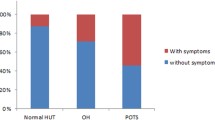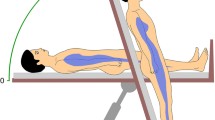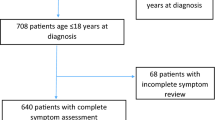Abstract
Purpose
Healthy subjects with asymptomatic postural tachycardia (≥30 bpm) at baseline were evaluated over a 1-year period to determine whether they developed orthostatic symptoms.
Methods
Subjects were evaluated at baseline and at 1 year using the autonomic reflex screen and autonomic symptom profile (ASP).
Results
Heart rate increment on HUT did not differ at baseline (40.6 ± 7.5 bpm) or at 1 year (37.1 ± 11.1 bpm; n = 26; p > 0.05). Orthostatic symptoms measured by the ASP did not reveal significant orthostatic dysfunction throughout follow-up (baseline, 7.88 ± 7.61; 1 year, 9.04 ± 6.64; n = 26; p > 0.05). The ten autonomic domains of the ASP did not reveal a change in autonomic symptoms from baseline (13.56 ± 13.66) to 1-year follow-up (15.12 ± 11.62; n = 26; p > 0.05). Cardiovagal function was unchanged between baseline and follow-up for both heart rate variability to deep breathing (baseline, 23.9 ± 11.6 bpm; 1 year, 23.0 ± 9.3 bpm; n = 26; p > 0.05) and Valsalva ratio (baseline, 2.16 ± 0.39; 1 year, 2.15 ± 0.33; n = 26; p > 0.05).
Conclusions
These findings further argue that heart rate criteria (≥30 bpm) for Postural Tachycardia Syndrome (POTS) are not appropriate in younger individuals and higher postural heart rates do not predispose individuals to the development of POTS.



Similar content being viewed by others
References
Antiel RM, Risma JM, Grothe RM, Brands CK, Fischer PR (2008) Orthostatic intolerance and gastrointestinal motility in adolescents with nausea and abdominal pain. J Pediatr Gastroenterol Nutr 46:285–288
Benrud-Larson LM, Dewar MS, Sandroni P, Rummans TA, Haythornthwaite JA, Low PA (2002) Quality of life in patients with postural tachycardia syndrome. Mayo Clin Proc 77:531–537
Benrud-Larson LM, Sandroni P, Haythornthwaite JA, Rummans TA, Low PA (2003) Correlates of functional disability in patients with postural tachycardia syndrome: preliminary cross-sectional findings. Health Psychol 22:643–648
Garland EM, Raj SR, Black BK, Harris PA, Robertson D (2007) The hemodynamic and neurohumoral phenotype of postural tachycardia syndrome. Neurology 69:790–798
Hoad A, Spickett G, Elliott J, Newton J (2008) Postural orthostatic tachycardia syndrome is an under-recognized condition in chronic fatigue syndrome. QJM 101:961–965
Ives CT, Berger MJ, Kimpinski K (2013) The autonomic reflex screen in healthy participants from southwestern ontario. Can J Neurol Sci 40:848–853
Ives CT, Kimpinski K (2013) Higher postural heart rate increments on head-up tilt correlate with younger age but not orthostatic symptoms. J Appl Physiol 115:525–528
Ives CT, Kimpinski K (2013) Higher postural heart rate increments on head-up tilt correlate with younger age but not orthostatic symptoms. J Appl Physiol 13:13
Ives CT, Kimpinski K (2014) Higher heart rate increments on head-up tilt in control subjects are not associated with autonomic dysfunction. Clin Neurophysiol. doi:10.1016/j.clinph.2014.02.014
Jacob G, Costa F, Shannon JR, Robertson RM, Wathen M, Stein M, Biaggioni I, Ertl A, Black B, Robertson D (2000) The neuropathic postural tachycardia syndrome. N Engl J Med 343:1008–1014
Johnson JN, Mack KJ, Kuntz NL, Brands CK, Porter CJ, Fischer PR (2010) Postural orthostatic tachycardia syndrome: a clinical review. Pediatr Neurol 42:77–85
Kanjwal K, Saeed B, Karabin B, Kanjwal Y, Grubb BP (2011) Clinical presentation and management of patients with hyperadrenergic postural orthostatic tachycardia syndrome. A single center experience. Cardiol J 18:527–531
Kimpinski K, Figueroa JJ, Singer W, Sletten DM, Iodice V, Sandroni P, Fischer PR, Opfer-Gehrking TL, Gehrking JA, Low PA (2012) A prospective, 1-year follow-up study of postural tachycardia syndrome. Mayo Clin Proc 87:746–752
Lewis I, Pairman J, Spickett G, Newton JL (2012) Clinical characteristics of a novel subgroup of chronic fatigue syndrome patients with postural orthostatic tachycardia syndrome. J Intern Med 4:12022
Low PA (1993) Composite autonomic scoring scale for laboratory quantification of generalized autonomic failure. Mayo Clin Proc 68:748–752
Low PA (2003) Testing the autonomic nervous system. Semin Neurol 23:407–421
Low PA, Denq JC, Opfer-Gehrking TL, Dyck PJ, O’Brien PC, Slezak JM (1997) Effect of age and gender on sudomotor and cardiovagal function and blood pressure response to tilt in normal subjects. Muscle Nerve 20:1561–1568
Low PA, Opfer-Gehrking TL (1999) The autonomic laboratory. Neurodiagnostic J 39:65–76
Low PA, Sandroni P, Joyner MJ, Shen WK (2009) Postural tachycardia syndrome (POTS). J Cardiovasc Electrophysiol 20:352–358
Low PA, Sletten DM (2008) Laboratory Evaluation of Autonomic Failure. In: Low PA, Benarroch EE (eds) Clinical autonomic disorders. Lippincott Williams & Wilkins, Philadelphia, pp 130–163
Ojha A, Chelimsky TC, Chelimsky G (2011) Comorbidities in pediatric patients with postural orthostatic tachycardia syndrome. J Pediatr 158:20–23
Peltier AC, Garland E, Raj SR, Sato K, Black B, Song Y, Wang L, Biaggioni I, Diedrich A, Robertson D (2010) Distal sudomotor findings in postural tachycardia syndrome. Clin Auton Res 20:93–99
Raj V, Haman KL, Raj SR, Byrne D, Blakely RD, Biaggioni I, Robertson D, Shelton RC (2009) Psychiatric profile and attention deficits in postural tachycardia syndrome. J Neurol Neurosurg Psychiatry 80:339–344
Schondorf R, Low PA (1993) Idiopathic postural orthostatic tachycardia syndrome: an attenuated form of acute pandysautonomia? Neurology 43:132–137
Singer W, Sletten DM, Opfer-Gehrking TL, Brands CK, Fischer PR, Low PA (2012) Postural tachycardia in children and adolescents: what is abnormal? J Pediatr 160:222–226
Staud R (2008) Autonomic dysfunction in fibromyalgia syndrome: postural orthostatic tachycardia. Curr Rheumatol Rep 10:463–466
Stewart JM (2000) Autonomic nervous system dysfunction in adolescents with postural orthostatic tachycardia syndrome and chronic fatigue syndrome is characterized by attenuated vagal baroreflex and potentiated sympathetic vasomotion. Pediatr Res 48:218–226
Stewart JM (2002) Pooling in chronic orthostatic intolerance: arterial vasoconstrictive but not venous compliance defects. Circulation 105:2274–2281
Stewart JM, Medow MS, Montgomery LD (2003) Local vascular responses affecting blood flow in postural tachycardia syndrome. Am J Physiol Heart Circ Physiol 285:14
Suarez GA, Opfer-Gehrking TL, Offord KP, Atkinson EJ, O’Brien PC, Low PA (1999) The autonomic symptom profile: a new instrument to assess autonomic symptoms. Neurology 52:523–528
Conflict of interest
On behalf of all authors, the corresponding author states that there is no conflict of interest.
Author information
Authors and Affiliations
Corresponding author
Rights and permissions
About this article
Cite this article
Corkal, J.C., Kimpinski, K. A prospective study of excessive postural heart rate change on head-up tilt. Clin Auton Res 24, 253–258 (2014). https://doi.org/10.1007/s10286-014-0254-x
Received:
Accepted:
Published:
Issue Date:
DOI: https://doi.org/10.1007/s10286-014-0254-x




